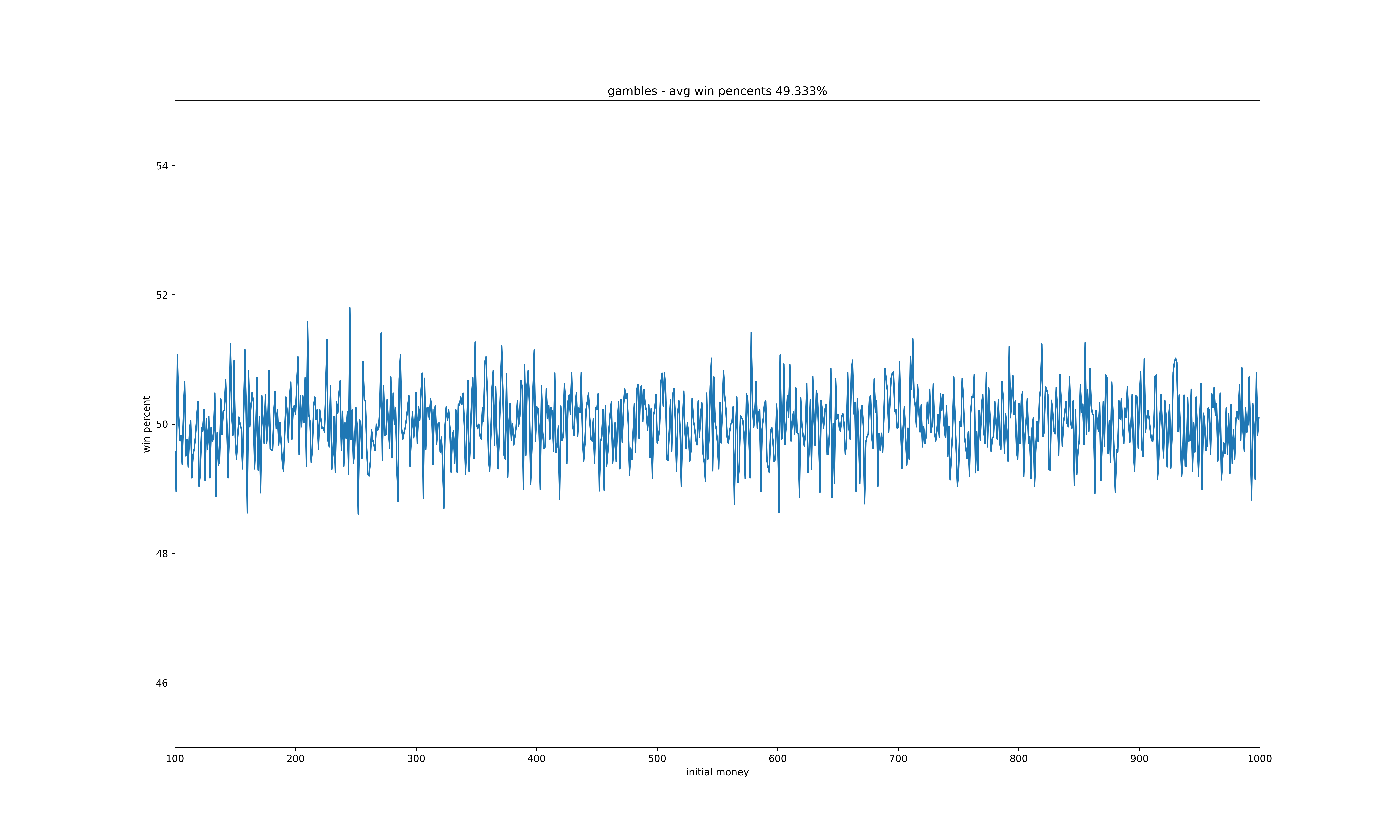一、赌徒的问题
周末闲来无事,打算解决我一直思考的一个问题。假设我有100块钱,拿去赌博,每次从1块开始押,如果赢了,下次还是押一块,如果输了,下次就押两块,输了就继续翻倍,直到将手上的钱输光为止。如果以这种方式赌博,是否是稳赚不赔,如果要赢到200块,需要赌多少把。来吧,我们开始写程序验证。
二、程序验证
import random
def gamble(money):
"""
赌博,赢到双倍,或输光,程序退出
:param money: 进场金额
:return:
"""
total_money = money # 进场的总金额
lay = 1 # 初始下注的金额
lay_cnt = 0 # 下注的次数
win_cnt = 0 # 赢的次数
lose_cnt = 0 # 输的次数
win_lose = {1: '赢', 0: '输'}
while True:
initial_money = total_money
initial_lay = lay
win = random.choice([1, 0]) # 1表示赢,0表示输
lay_cnt += 1
if win: # 如果赢了,下次还是押一块
total_money += initial_lay
lay = 1
win_cnt += 1
else: # 如果输了,下次押2倍
total_money -= initial_lay
lay = 2 * lay
if total_money <= lay: # 如果手上的钱不够两倍,下次就押所有钱
lay = total_money
lose_cnt += 1
# print('押注次数:{}, 押注前金额:{}, 押注金额:{}, 结果:{}, 还剩下:{}, 下次押注:{}'.format(
# lay_cnt, initial_money, initial_lay, win_lose[win], total_money, lay
# ))
if total_money <= 0:
# print('输光了,赢的次数:{},输的次数:{}'.format(win_cnt, lose_cnt))
return 0
elif total_money >= 2*money:
# print('赢麻了,赢的次数:{},输的次数:{}'.format(win_cnt, lose_cnt))
return 1
def dogamble(money):
"""
验证胜率
:param money:
:return:
"""
gambles = 10000 # 赌博的次数
wins = 0
for cnt in range(gambles):
result = gamble(money)
wins += result
win_percent = round(100 * wins/gambles, 2)
return {money: win_percent}
if __name__ == '__main__':
import matplotlib.pyplot as plt
from concurrent.futures import ThreadPoolExecutor, as_completed
x = range(100, 1000) # 进场金额
y = {}
with ThreadPoolExecutor(max_workers=30) as executor:
all_task = [executor.submit(dogamble, num) for num in x]
for future in as_completed(all_task):
y.update(future.result())
y_list = [y.get(_) for _ in x]
# 算一下平均胜率
win_cnts = 0
for i in y_list:
if i > 50:
win_cnts += 1
avg_win_percents = round(100 * win_cnts / len(x), 3)
plt.rcParams['figure.figsize'] = (20, 12) # 设置图片大小
fig, ax = plt.subplots()
ax.plot(x, y_list)
ax.set(xlabel='initial money', ylabel='win percent', title='gambles - avg win pencents {}%'.format(avg_win_percents))
ax.set_xlim(100, 1000)
ax.set_ylim(40, 60)
plt.savefig('gambles', dpi=350) # 设置图片分辨率
三、结果

可以看到胜率都在50%上下徘徊,并没有因为进场的钱的增多而上升,而且平均胜率还只有49.333%,也就是采用这种方式赌博并不比随机的输赢胜率高。
有兴趣的同学可以设置下,输赢到一半的进场钱就退出的胜率如何,我这里就不研究了。
好了,在我想出稳赚不赔的想法之前,还是老老实实搬砖吧。